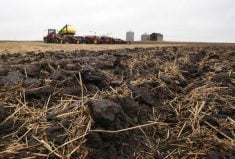A lot has changed in the phosphate market recently, but in a way, nothing has changed, says an analyst.
Earlier this month the U.S. Department of Commerce announced it was slashing import duties on product from Morocco.
The duties were lowered to 2.12 percent from 19.97 percent, providing an incentive for Moroccan phosphate producer OCP to re-enter the U.S. market.
Read Also

New coal mine proposal met with old concerns
A smaller version of the previously rejected Grassy Mountain coal mine project in Crowsnest Pass is back on the table, and the Livingstone Landowners Group continues to voice concerns about the environmental risks.
It was seen as a huge victory for U.S. farmers because the expectation before the announcement was that the duty would fall to around 15 percent.
The duties were initially applied in 2020 at the behest of Mosaic, after the U.S. fertilizer manufacturer successfully argued Morocco and Russia were flooding the market with unfairly subsidized product.
That didn’t sit well with American farmers, who argued that the duties on Moroccan product added $7 per acre to their input costs.
The National Corn Growers Association, the American Soybean Association and the National Cotton Council launched an intense lobby effort to get the duties removed.
They were elated when the Department of Commerce slashed the duty on Moroccan product.
“Everybody was so happy,” said Josh Linville, fertilizer analyst with StoneX.
However, he believes the celebration will be short-lived because he doesn’t anticipate that Moroccan manufacturer OCP will be re-entering the market anytime soon.
“I don’t think that they’re going to come to the U.S. in a big way,” he said.
That is bad news for both U.S. and Canadian farmers because the two markets are intertwined when it comes to phosphate.
A two percent duty may sound low, but when diammonium phosphate (DAP) is selling for US$520 to $530 per tonne in New Orleans, that’s still a $10 per tonne levy.
“That’s serious money,” said Linville.
Plus, OCP has been arguing the duty needs to be eliminated completely, so suddenly flooding the market with product would undermine that argument.
It looks like OCP will have plenty of alternative options for shipping its phosphate around the world, considering China recently announced it is implementing export restrictions on the commodity. It is the world’s largest producer and exporter of DAP and MAP.
China was already shut out of the U.S. market because of a 25 percent import duty dating back to former U.S. president Donald Trump’s trade war with the country.
However, it opens opportunities in other markets. The timing of China’s announcement couldn’t have been better for OCP.
“Now the world is their oyster. They can go anywhere else around the world that China has departed before they go to the U.S.,” said Linville.
Even if the OCP duty had been fully eliminated, it would not have had an impact on fall fertilizer prices in North America.
If OCP had a vessel at port side fully loaded with phosphate fertilizer and ready to push off, it wouldn’t arrive in New Orleans until early December.
It would take another 30 days to work its way to the upper Midwest or Canada.
“Put a ribbon on it, it’s a Christmas present by that point,” he said.
However, the hope was that the Department of Commerce ruling would drive down prices in time for spring 2024.
“Unfortunately, that doesn’t really hold a lot of water either,” said Linville.
He noted that while it was lowering the Moroccan duties, the Department of Commerce increased duties on Russian product to 28.5 percent from 9.19 percent.
“It basically means that we’re not going to see tonnes come from Russia,” said Linville.
“If they do start bringing stuff here, there is probably something very seriously wrong with the world of phosphate.”
The upshot is that the U.S. will not be receiving any additional supplies from the top three exporters in the world.
And fall demand for phosphate is expected to be strong in the U.S. despite higher-than-normal prices for the product. Low potash prices have farmers in a buying mood, and that sentiment is spilling over to phosphate.
Linville said phosphate prices are historically high, but they are about half of the peak in March-April 2022, when the market was concerned Russian supplies would be completely cut off.
The market has gotten used to the “fear factor” of the war in Ukraine.
“When something happens for the first time, it’s scary. You don’t know what to expect,” he said.
The phosphate market is no longer “freaking out” about the Ukraine conflict, but there are still plenty of other scary factors, such as the possibility of a full-fledged war in the Middle East, China’s export restrictions and U.S. duties.
That is why Linville is encouraging growers to talk to their retailer about securing supplies of the product and to consider buying their nutrient inputs while simultaneously selling some high-priced grain.
The spread between the two is attractive right now, especially for a product such as urea.
“Lock in both sides of that equation,” he said.
“Look for value. Don’t try to call the bottom or the top.”
Contact sean.pratt@producer.com


















